IPv6 Rapid Deployment (6rd) allows IPv6 clients and IPv6 servers that are separated by IPv4 networks to communicate without changing the IPv4 network.
6rd also uses CGN standards for the NAT component. For more information, see Large Scale Network Address Translation. For information about logging, see the Traffic Logging Guide for IPv6 Migration.
To send the IPv6 traffic over IPv4, 6rd uses an IPv4 tunnel. The tunnel origination point on the sender’s side of the tunnel encapsulates the IPv6 traffic in IPv4 packets and sends these packets over IPv4 to the device at the remote end of the tunnel. The device at the remote end of the tunnel decapsulates the packets and sends them over the IPv6 network to their destination.
FIGURE 28 illustrates an example of a 6rd deployment, the traffic flow for an IPv6 client request to an IPv6 server, and the server reply to the client.

In this example, a service provider has operational control of 6rd domain 6rd1, and provides 6rd service to IPv6 clients in this domain.
The following procedure provides the high-level steps for this process:
1. Client 2001:db8:00:b:1::1 sends an IPv6 request to server 2001::4. For information about how 6rd client addresses are formed, see 6rd Prefix and Delegated Prefix.
2. The customer edge (CE) router at the client site encapsulates the IPv6 request in one or more IPv4 packets and sends the request over IPv4 to the ACOS device.
The ACOS device is configured as the 6rd Border Relay (BR) for the 6rd domain.
3. The 6rd border relay (BR), the ACOS device, decapsulates the request and sends it over the IPv6 network to the IPv6 server.
4. The IPv6 server sends the reply over the IPv6 network.
5. The 6rd BR (ACOS device) encapsulates the reply in one or more IPv4 packets and sends them to the client’s CE router.
6. The CE router decapsulates the reply and sends it to the client.
NOTE: For the ACOS BR address, you can use an IP address that is configured on an ACOS interface or a floating-IP address. If you use an IP address that is configured on an ACOS interface, the 6rd domain is not synchronized to the standby ACOS device as part of configuration synchronization.













